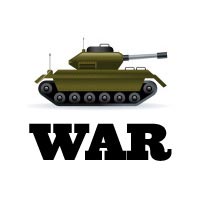Hollywood's War Films of WWII At the Time of the Conflict:
 After
the bombing of Pearl Harbor by the Japanese in late 1941, the mood of Hollywood
changed dramatically. Once the war began, the US film industry bolstered American
support by churning out many war-themed movies. Most of the films were propaganda
depicting the U.S. entry into the war as a noble cause, but some displayed
the human side as well. The all-time film classic of pre-World War II intrigue,
patriotism and romance, Casablanca (1942) was released just weeks after the liberation
of the city itself. The popular film emphasized the atmospheric intrigue and
tension surrounding Humphrey Bogart's decision to assist the war effort and
get involved by securing transit visas - and give up the one-time love of
his life, the often tragic consequences for lovers caught up in wartime experiences.
Director Vincente Minnelli's The Clock (1945) another war-time film
with a romantic sub-plot, was about a NYC office worker Judy Garland (Minnelli's
wife) who fell in love with Robert Walker, a soldier on two-day leave. After
the bombing of Pearl Harbor by the Japanese in late 1941, the mood of Hollywood
changed dramatically. Once the war began, the US film industry bolstered American
support by churning out many war-themed movies. Most of the films were propaganda
depicting the U.S. entry into the war as a noble cause, but some displayed
the human side as well. The all-time film classic of pre-World War II intrigue,
patriotism and romance, Casablanca (1942) was released just weeks after the liberation
of the city itself. The popular film emphasized the atmospheric intrigue and
tension surrounding Humphrey Bogart's decision to assist the war effort and
get involved by securing transit visas - and give up the one-time love of
his life, the often tragic consequences for lovers caught up in wartime experiences.
Director Vincente Minnelli's The Clock (1945) another war-time film
with a romantic sub-plot, was about a NYC office worker Judy Garland (Minnelli's
wife) who fell in love with Robert Walker, a soldier on two-day leave.
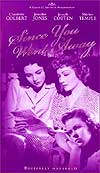 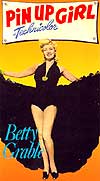 Other
films that portrayed the WWII homefront included The Human Comedy (1943) with Mickey Rooney as a telegram delivery boy in a small town, and John Cromwell's
and producer David O. Selznick's black and white Since
You Went Away (1944), with Claudette Colbert as the mother of two
daughters while her husband was away at war: Jennifer Jones (in a doomed romance
with departing serviceman Robert Walker) and teenaged Shirley Temple. Wyler's The Best Years of Our Lives (1946) depicted the difficulties of demobilization
and the problems of three veterans (Dana Andrews, Fredric March, and Harold
Russell) adjusting and returning to American civilian life. Fred Zinnemann's
gritty The Men (1950), Marlon Brando's first film, examined the problems
of WWII veteran paraplegics. Other
films that portrayed the WWII homefront included The Human Comedy (1943) with Mickey Rooney as a telegram delivery boy in a small town, and John Cromwell's
and producer David O. Selznick's black and white Since
You Went Away (1944), with Claudette Colbert as the mother of two
daughters while her husband was away at war: Jennifer Jones (in a doomed romance
with departing serviceman Robert Walker) and teenaged Shirley Temple. Wyler's The Best Years of Our Lives (1946) depicted the difficulties of demobilization
and the problems of three veterans (Dana Andrews, Fredric March, and Harold
Russell) adjusting and returning to American civilian life. Fred Zinnemann's
gritty The Men (1950), Marlon Brando's first film, examined the problems
of WWII veteran paraplegics.
One of the most rousing, propagandist musicals was Yankee Doodle Dandy (1942), with Best Actor-winning James Cagney
as vaudevillian George M. Cohan - the film included such patriotic hits as
"You're a Grand Old Flag," "Over There," and the title song itself. Flag-waving
Hollywood films in the mid-1940s that boosted morale also included other technicolor
musicals, most notably Rita Hayworth in Cover Girl (1944), Betty Grable
in Pin-Up Girl (1944) with the leggy star as a USO entertainer, and
Gene Kelly as a dancing sailor (on leave), accompanied by Frank Sinatra, in
MGM's extravagant Anchors Aweigh (1945) - the first of their three
musicals. (This was the film in which Kelly danced with cartoon mouse Jerry
(of Tom and Jerry fame).
WWII War Films of the Actual Fighting:
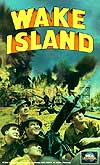 More films have been made about World War II than about any other armed
hostility in American history. World
War II is easily the most popular war choice for Hollywood film-makers, due
in large part to its clear-cut political struggle against the Nazi regime. More films have been made about World War II than about any other armed
hostility in American history. World
War II is easily the most popular war choice for Hollywood film-makers, due
in large part to its clear-cut political struggle against the Nazi regime.
During the early to mid-war years, as the United States
struggled and suffered setbacks, many films provided a genuine depiction
of the fighting and the human effects of WWII. Most of Hollywood's
films were concerned with combat in the Pacific Theatre of the war.
Director John Farrow's flag-waving Wake
Island (1942), one of the most realistic and factually-based films
made about the war, told of gallant US Marines (including Brian Donlevy,
William Bendix and Robert Preston) fighting against the Japanese with
uneven odds to hold onto a tiny base on the remote S. Pacific island
shortly after the attack on Pearl Harbor. Lewis Seiler's exciting,
flag-waving, documentary-style adventure film Guadalcanal Diary (1943),
with stars Anthony Quinn, William Bendix and Preston Foster, bolstered
homefront morale as it portrayed the courageous and bloody battle of
the US Marines for the Solomon Islands during the opening stages of
the war in the South Pacific.
Both Paramount's and Mark Sandrich's So Proudly We Hail!
(1943), and Richard Thorpe's and MGM's Cry Havoc (1943) attempted
to realistically depict the role of women during wartime; the first depicted
deglamorized, Red Cross combat nurses in WWII Pacific with Claudette Colbert,
Paulette Goddard and Veronica Lake, the second with Margaret Sullavan, Ann
Sothern, and Joan Blondell as nurses and other courageous volunteers in the
Bataan-Corregidor-Philippines conflicts.
 Tay Garnett's documentary-style Bataan (1943), loosely based on John
Ford's earlier film The Lost Patrol (1934), chronicled the rugged exploits
of a small US Army platoon in the Philippines (led by Robert Taylor) in 1942
left for rear-guard action in the jungle to fight against the Japanese and
blow up a strategic bridge. Ray Enright's ultra-patriotic film Gung Ho!
(1943) showcased Robert Mitchum and Randolph Scott as members of Carlson's
Marine Raider Battalion fighting a death-defying mission in the Pacific island
jungles to retake Makin Island in the Pacific in August, 1942. William A.
Wellman's poignant but unsentimental The Story of G.I. Joe (1945),
released just after the German surrender, was one of the best of all
WWII combat films - the story of Company C, 18th Infantry foot-soldiers chronicled
by war correspondent Ernie Pyle (portrayed by Burgess Meredith). [Robert Mitchum
earned his only Oscar nomination for this film.] Errol Flynn starred in Raoul
Walsh's realistic combat film Objective, Burma! (1945), as Major Nelson
- a gung-ho paratrooper captain leading a platoon in an attack against a Japanese
radar station jungle outpost in Burma. Their return trip to their own lines,
a harrowing, arduous 150-mile foot trek through the jungle, portrayed their
sacrifice, pain, and heroism. Tay Garnett's documentary-style Bataan (1943), loosely based on John
Ford's earlier film The Lost Patrol (1934), chronicled the rugged exploits
of a small US Army platoon in the Philippines (led by Robert Taylor) in 1942
left for rear-guard action in the jungle to fight against the Japanese and
blow up a strategic bridge. Ray Enright's ultra-patriotic film Gung Ho!
(1943) showcased Robert Mitchum and Randolph Scott as members of Carlson's
Marine Raider Battalion fighting a death-defying mission in the Pacific island
jungles to retake Makin Island in the Pacific in August, 1942. William A.
Wellman's poignant but unsentimental The Story of G.I. Joe (1945),
released just after the German surrender, was one of the best of all
WWII combat films - the story of Company C, 18th Infantry foot-soldiers chronicled
by war correspondent Ernie Pyle (portrayed by Burgess Meredith). [Robert Mitchum
earned his only Oscar nomination for this film.] Errol Flynn starred in Raoul
Walsh's realistic combat film Objective, Burma! (1945), as Major Nelson
- a gung-ho paratrooper captain leading a platoon in an attack against a Japanese
radar station jungle outpost in Burma. Their return trip to their own lines,
a harrowing, arduous 150-mile foot trek through the jungle, portrayed their
sacrifice, pain, and heroism.
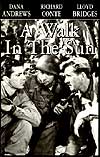 Warner
Bros.' action picture Action in the North Atlantic (1943) featured
Humphrey Bogart as a commander in the unheralded Merchant Marines, protecting
a convoy (carrying valuable cargo to the Soviet allies) against U-boat attacks.
Lewis Milestone's modest A Walk in the Sun (1945) followed an American
infantry unit (with Dana Andrews as their sergeant) struggling to survive
while fighting to take a farmhouse from the Germans in Italy. Zoltan Korda's
dramatic action picture Sahara (1943) was centered in the N. African
Libyan desert, with Humphrey Bogart as the head of a British-American unit
fighting the Germans. Another war film geographically located in N. Africa
was John Stahl's The Immortal Sergeant (1943), with Henry Fonda as
an inexperienced Canadian Army Corporal forced to take command of the British
8th Army troops in the desert following the battle death of the squad's sergeant
(Thomas Mitchell). Warner
Bros.' action picture Action in the North Atlantic (1943) featured
Humphrey Bogart as a commander in the unheralded Merchant Marines, protecting
a convoy (carrying valuable cargo to the Soviet allies) against U-boat attacks.
Lewis Milestone's modest A Walk in the Sun (1945) followed an American
infantry unit (with Dana Andrews as their sergeant) struggling to survive
while fighting to take a farmhouse from the Germans in Italy. Zoltan Korda's
dramatic action picture Sahara (1943) was centered in the N. African
Libyan desert, with Humphrey Bogart as the head of a British-American unit
fighting the Germans. Another war film geographically located in N. Africa
was John Stahl's The Immortal Sergeant (1943), with Henry Fonda as
an inexperienced Canadian Army Corporal forced to take command of the British
8th Army troops in the desert following the battle death of the squad's sergeant
(Thomas Mitchell).
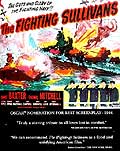 Lloyd
Bacon's The Sullivans - re-released as The Fighting Sullivans (1944) told the patriotic true story of five Irish-American brothers who died together
in WWII, when their ship was sunk in the South Pacific. [Years later, the
film inspired director Steven Spielberg to rework the story into his film Saving Private Ryan (1998).] Lloyd
Bacon's The Sullivans - re-released as The Fighting Sullivans (1944) told the patriotic true story of five Irish-American brothers who died together
in WWII, when their ship was sunk in the South Pacific. [Years later, the
film inspired director Steven Spielberg to rework the story into his film Saving Private Ryan (1998).]
The first significant post-WWII film in the US was MGM's Battleground
(1949) - it followed a group of raw American recruits of the 101st Airborne
Infantry Division fighting in the Battle of the Bulge. [Later, Robert Aldrich's Attack! (1956), also set during the 1944 Battle of the Bulge,
featured Jack Palance in a lead role as a desperate fighting man.] Home
of the Brave (1949), notable for being Hollywood's earliest protestation
against racial bigotry in the military, depicted a black soldier sent on a
S. Pacific island mission who faced prejudicial treatment by white comrades.
The screen duo of Alan Ladd and Veronica Lake were paired
in their fourth (and final) film together in Saigon (1948), a romantic
adventure set mostly in a SE Asian jungle near Saigon. In Jean Negulesco's
non-fictional, agonizing Three Came Home (1950), Claudette Colbert
starred as American authoress Agnes Newton Keith, penned-up with her young
son in a Japanese prisoner of war camp in Borneo (headed by Sessue Hayakawa).
Decorated military hero and Medal of Honor winner, Audie Murphy starred in
the autobiographical To Hell and Back (1955) about his war-time experiences
in the 3rd Infantry Division in S. France and Italy. And Philip Dunne's In
Love and War (1958) told the story of three Marine leathernecks (Jeffrey
Hunter, Robert Wagner, and Bradford Dillman) from N. California who served
in the South Pacific.
Submarine and Naval-Related Pictures:
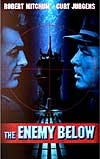 Another
propagandistic film, Delmer Daves' quintessential submarine feature film Destination
Tokyo (1943), starred Cary Grant as the captain of a submarine crew on
a dangerous mission to Tokyo Bay. Archie Mayo's hard-hitting Crash Dive
(1943) starred Tyrone Power as an ace PT boat skipper whose assignment
to a submarine (commanded by Dana Andrews) led to victories against the Nazis
in the North Atlantic, with a romantic adventure subplot (with love interest
Anne Baxter). Hitchcock depicted eight survivors from a torpedoed boat adrift
in Lifeboat (1944). Director Dick Powell's The Enemy Below (1957) dealt with submarine warfare in the Atlantic between two dueling commanders
(Robert Mitchum as the captain of an American destroyer, and Curt Jurgens
as the captain of a German U-boat). Another seminal submarine film was Robert
Wise's Run Silent, Run Deep (1958) with Burt Lancaster and Clark Gable
as two clashing submarine officers. In the same year, Torpedo Run (1958) starred Glenn Ford as an obsessed and merciless WWII submarine commander.
John Ford's comedy/drama Mister Roberts (1955) examined the crew of
a Navy cargo freighter outside the battle zone in the S. Pacific during WW
II. Another
propagandistic film, Delmer Daves' quintessential submarine feature film Destination
Tokyo (1943), starred Cary Grant as the captain of a submarine crew on
a dangerous mission to Tokyo Bay. Archie Mayo's hard-hitting Crash Dive
(1943) starred Tyrone Power as an ace PT boat skipper whose assignment
to a submarine (commanded by Dana Andrews) led to victories against the Nazis
in the North Atlantic, with a romantic adventure subplot (with love interest
Anne Baxter). Hitchcock depicted eight survivors from a torpedoed boat adrift
in Lifeboat (1944). Director Dick Powell's The Enemy Below (1957) dealt with submarine warfare in the Atlantic between two dueling commanders
(Robert Mitchum as the captain of an American destroyer, and Curt Jurgens
as the captain of a German U-boat). Another seminal submarine film was Robert
Wise's Run Silent, Run Deep (1958) with Burt Lancaster and Clark Gable
as two clashing submarine officers. In the same year, Torpedo Run (1958) starred Glenn Ford as an obsessed and merciless WWII submarine commander.
John Ford's comedy/drama Mister Roberts (1955) examined the crew of
a Navy cargo freighter outside the battle zone in the S. Pacific during WW
II.
Aircraft-Related Pictures:
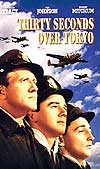 Victor Fleming's morale-boosting A Guy Named Joe (1943) told a fanciful
war tale of the death of a WWII pilot (Spencer Tracy) who was sent back to
Earth (by a Godly Lionel Barrymore) to become a guardian angel to a group
of new pilots being trained for missions. [It was later remade by director
Steven Spielberg, as the romantic fantasy Always (1989) with Richard
Dreyfuss as a fire-fighting pilot - unrelated to the military context.] Director
Howard Hawks' Air Force (1943) from Warner Bros.' studios, and
with James Wong Howe's cinematographic genius, was a strong propagandistic
film about the crew of a B-17 Flying Fortress plane - with believable aerial
battles. Mervyn LeRoy's Thirty Seconds Over Tokyo (1944) with Oscar-winning
Special Effects, starred Spencer Tracy as Lieut. Colonel James H. Doolittle,
famous for leading the first bombing attack on Tokyo during WWII. Director
Henry Hathaway's A Wing and a Prayer (1944) told of brave pilots on
an aircraft carrier led by a tough flight officer (Don Ameche). In Sam Wood's Command Decision (1948), Clark Gable portrayed a British air force
base commander who agonized over sending dangerous bombing squadrons over
Germany. Director Henry King's Twelve O'Clock High (1949) featured
Gregory Peck (in one of his finest career roles) as a ruthless flight commander
straining to lead an England-based American bomber squadron (the 8th Air Force).
The film with an all-male cast portrayed the mental and psychological pressures
of warfare. Victor Fleming's morale-boosting A Guy Named Joe (1943) told a fanciful
war tale of the death of a WWII pilot (Spencer Tracy) who was sent back to
Earth (by a Godly Lionel Barrymore) to become a guardian angel to a group
of new pilots being trained for missions. [It was later remade by director
Steven Spielberg, as the romantic fantasy Always (1989) with Richard
Dreyfuss as a fire-fighting pilot - unrelated to the military context.] Director
Howard Hawks' Air Force (1943) from Warner Bros.' studios, and
with James Wong Howe's cinematographic genius, was a strong propagandistic
film about the crew of a B-17 Flying Fortress plane - with believable aerial
battles. Mervyn LeRoy's Thirty Seconds Over Tokyo (1944) with Oscar-winning
Special Effects, starred Spencer Tracy as Lieut. Colonel James H. Doolittle,
famous for leading the first bombing attack on Tokyo during WWII. Director
Henry Hathaway's A Wing and a Prayer (1944) told of brave pilots on
an aircraft carrier led by a tough flight officer (Don Ameche). In Sam Wood's Command Decision (1948), Clark Gable portrayed a British air force
base commander who agonized over sending dangerous bombing squadrons over
Germany. Director Henry King's Twelve O'Clock High (1949) featured
Gregory Peck (in one of his finest career roles) as a ruthless flight commander
straining to lead an England-based American bomber squadron (the 8th Air Force).
The film with an all-male cast portrayed the mental and psychological pressures
of warfare.
John Wayne's WWII Films:
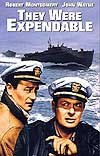 John
Wayne starred in the fictionalized The Flying Tigers (1942) as the
leader of a squadron of American pilots stationed in early-WWII China that
were for-hire to battle the Japanese. In The Fighting Seabees (1944),
Wayne also starred as the leader of a crew of civilians in a construction
company that eventually formed a tough fighting force in WWII. Back to
Bataan (1945) found John Wayne leading US forces in a recreation of the
Bataan Death March. Toward the close of the war, John Ford based his realistic,
under-rated and bleak film They Were Expendable (1945) upon the true,
inspiring story of the Navy's PT boat squadrons and crews based in the Philippines
during the early years of the war that faced the advance of Japanese forces,
with John Wayne and Robert Montgomery in starring roles. John
Wayne starred in the fictionalized The Flying Tigers (1942) as the
leader of a squadron of American pilots stationed in early-WWII China that
were for-hire to battle the Japanese. In The Fighting Seabees (1944),
Wayne also starred as the leader of a crew of civilians in a construction
company that eventually formed a tough fighting force in WWII. Back to
Bataan (1945) found John Wayne leading US forces in a recreation of the
Bataan Death March. Toward the close of the war, John Ford based his realistic,
under-rated and bleak film They Were Expendable (1945) upon the true,
inspiring story of the Navy's PT boat squadrons and crews based in the Philippines
during the early years of the war that faced the advance of Japanese forces,
with John Wayne and Robert Montgomery in starring roles.
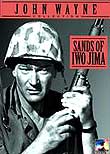 In
director Allan Dwan's blatantly-patriotic wartime action drama Sands of
Iwo Jima (1949) made after the war by Republic Studios, Wayne again starred
as a tough and harsh but compassionate Marine sergeant (acquiring his first
Academy Award nomination for the role) who trained rebellious recruit-troops
in New Zealand in 1943 that were eventually responsible for the strategic
re-taking of Iwo Jima (on top of Mount Suribachi) from the Japanese in February,
1945. And in Operation Pacific (1951), Wayne starred as an American
submarine captain of the USS Growler - a story adapted from the life
of sub-commander Howard W. Gilmore. In director Nicholas Ray's Flying
Leathernecks (1951), Wayne played a disciplined, unpopular and macho-tough
Marine squadron commander of the Flying Corps in the South Pacific, leading
a group to hold Guadalcanal in WWII. Director Otto Preminger's star-studded
epic In Harm's Way (1965), another WWII naval adventure, re-teamed
Wayne (as a veteran cruiser commander) with co-star Patricia Neal. It appeared
two decades after the war's end to present an overlong story of naval life
during wartime and a depiction of the attack on Pearl Harbor. In
director Allan Dwan's blatantly-patriotic wartime action drama Sands of
Iwo Jima (1949) made after the war by Republic Studios, Wayne again starred
as a tough and harsh but compassionate Marine sergeant (acquiring his first
Academy Award nomination for the role) who trained rebellious recruit-troops
in New Zealand in 1943 that were eventually responsible for the strategic
re-taking of Iwo Jima (on top of Mount Suribachi) from the Japanese in February,
1945. And in Operation Pacific (1951), Wayne starred as an American
submarine captain of the USS Growler - a story adapted from the life
of sub-commander Howard W. Gilmore. In director Nicholas Ray's Flying
Leathernecks (1951), Wayne played a disciplined, unpopular and macho-tough
Marine squadron commander of the Flying Corps in the South Pacific, leading
a group to hold Guadalcanal in WWII. Director Otto Preminger's star-studded
epic In Harm's Way (1965), another WWII naval adventure, re-teamed
Wayne (as a veteran cruiser commander) with co-star Patricia Neal. It appeared
two decades after the war's end to present an overlong story of naval life
during wartime and a depiction of the attack on Pearl Harbor.
More WWII-Related Films:
Emeric Pressburger's and Michael Powell's propaganda film ...One of Our Aircraft is Missing (1941, UK) told about a night-time
RAF bomber crew shot down and aided by the Dutch in German-occupied territory. We Dive at Dawn (1943) told of the encounter between a British submarine
and a German warship in the Baltic Sea, with John Mills starring as the submarine
commander. Director Guy Hamilton's compelling British drama The Colditz
Story (1955) revealed the determination of Allied POWs in an escape from
Colditz - an escape-proof castle/prison within Germany's Third Reich. Raoul
Walsh's Battle Cry (1955), adapted from Leon Uris' best-seller, examined
a group of WWII Marine recruits (including Aldo Ray, James Whitmore, Tab Hunter
and others) led by their major (Van Heflin) in conflict in the South Pacific.
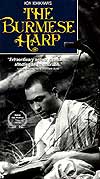 Japan's
(director Kon Ichikawa) anti-war film The Burmese Harp (1956) portrayed
the horror of war and Japanese post-war sentiment in its story of a Japanese
soldier (a lute player) separated from his battalion at the close of the Pacific
War in Burma, who is overwhelmed by the sight of dead Japanese soldiers in
Burma (at the end of the war). The devastating effects of the Hiroshima bombing
(and its radioactive fallout and radiation sickness), based on the prize-winning
novel by Masuji Ibuse, were chronicled in director Shohei Imamura's award-winning Black Rain (1989). Director Robert Pirosh's Go For Broke! (1951) was one of the few films to show the heroic courage of Japanese-Americans
of the 442nd Regimental Combat Team as they battled against the Nazis. Japan's
(director Kon Ichikawa) anti-war film The Burmese Harp (1956) portrayed
the horror of war and Japanese post-war sentiment in its story of a Japanese
soldier (a lute player) separated from his battalion at the close of the Pacific
War in Burma, who is overwhelmed by the sight of dead Japanese soldiers in
Burma (at the end of the war). The devastating effects of the Hiroshima bombing
(and its radioactive fallout and radiation sickness), based on the prize-winning
novel by Masuji Ibuse, were chronicled in director Shohei Imamura's award-winning Black Rain (1989). Director Robert Pirosh's Go For Broke! (1951) was one of the few films to show the heroic courage of Japanese-Americans
of the 442nd Regimental Combat Team as they battled against the Nazis.
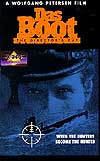 German
director Wolfgang Petersen's sympathetic and realistic Das Boot (1981),
adapted from the autobiographical book by Lothar-Guenther Buchheim,
followed the heroic efforts of a German U-boat captain and its crew during
WWII to patrol the Atlantic and Mediterranean within the claustrophic, cramped
confines of their undersea vessel (U-96). And the German anti-war battle drama Stalingrad (1993), from director Joseph Vilsmaier, was released to
coincide with the 50th anniversary of the crucial defeat of the Nazi forces
in Stalingrad/Russia. The German/Polish film, Europa, Europa (1990) (aka Hitlerjunge Salomon), by director Agnieszka Holland, was
based on the true story of a young, circumcised German Jew (Solomon Perel)
who survived the Holocaust by posing as an ethnic Aryan German and joining
the Hitler Youth, but continually feared being discovered by anti-Semitic
Nazis. German
director Wolfgang Petersen's sympathetic and realistic Das Boot (1981),
adapted from the autobiographical book by Lothar-Guenther Buchheim,
followed the heroic efforts of a German U-boat captain and its crew during
WWII to patrol the Atlantic and Mediterranean within the claustrophic, cramped
confines of their undersea vessel (U-96). And the German anti-war battle drama Stalingrad (1993), from director Joseph Vilsmaier, was released to
coincide with the 50th anniversary of the crucial defeat of the Nazi forces
in Stalingrad/Russia. The German/Polish film, Europa, Europa (1990) (aka Hitlerjunge Salomon), by director Agnieszka Holland, was
based on the true story of a young, circumcised German Jew (Solomon Perel)
who survived the Holocaust by posing as an ethnic Aryan German and joining
the Hitler Youth, but continually feared being discovered by anti-Semitic
Nazis.
Clint Eastwood directed two films (released in a 3-month period)
based on the pivotal WWII battle over the island of Iwo Jima: his 26th directed
film titled Flags of Our Fathers (2006), adapted from the co-authored
James Bradley and Ron Powers' non-fictional book Flags of Our Fathers:
Heroes of Iwo Jima that detailed the story surrounding the iconic and
familiar Pulitzer Prize-winning photograph by Joe Rosenthal on Mount Suribachi
called Raising the Flag at Iwo Jima. The film told of the bloody engagement
to take control of the Pacific island from the Japanese, with at least 6,000
Americans dying in the month-long conflict. The second film was Letters
From Iwo Jima (2006) which examined the same nihilistic battle from the
Japanese perspective. This bookend film, with Japanese dialogue (requiring
subtitles) starred Ken Watanabe as Japanese commander Lt. Gen. Tadamichi Kuribayashi,
who sent letters to his family - the basis for the film. |
